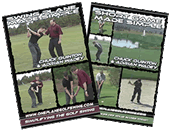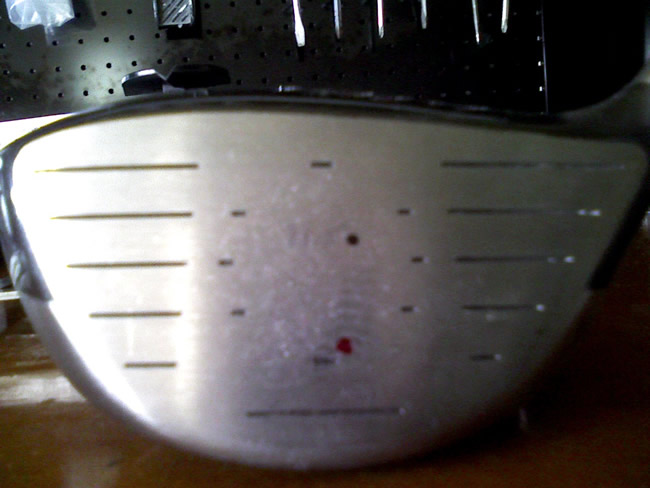by Chuck Quinton
"The Driver Sweetspot and Center of Gravity" |
Rotary Swing Golf |
In the first two videos in the "Bomb Your Driver" series I discussed the extreme importance of hitting the ball on the sweet spot of the driver and understanding the true loft of your club. In this next installment, prepare to have your eyes opened to the truth about the so-called driver "sweet spot". This term gets loosely thrown around a lot and there is a lot of misinformation out there. So to start, let's dispel some myths about the driver sweet spot that the club manufacturers would like for you to believe.
Myth Number 1: Our new “XYZ” driver has an "enlarged" sweet spot. The true sweet spot on a driver is the size of a pin point and simply CAN'T be made any bigger. There is only one true sweet spot on any driver where you will get maximum ball speed and no twisting of the driver head at impact. Missing this spot by the tiniest amount imparts sidespin on the ball and costs you ball speed and distance. In actuality, what these manufacturers are referring to is that their drivers are more forgiving in that when you do miss the sweet spot you will lose LESS ball speed and the club will twist LESS due to a higher Moment of Inertia, or MOI.
Myth Number 2: The sweet spot on a driver is in the exact center of the clubface. I really wish this were true, but as you will see in this video, the sweet spot position varies dramatically from model to model and is often not in the exact center in the face. In most modern drivers, the sweet spot is close to the center from heel to toe, but vertically, it has moved to a position above the center of the face. This has happened as club designers have been able to move discretionary weight from the face and crown to places lower and deeper in the head due to the use of lighter and stronger modern materials. This weight moves the Center of Gravity (COG) lower and further back which moves the sweet spot higher on the face. As I discuss in the video, this causes some significant and complicated issues when it comes to optimally fitting you for the perfect driver.
To demonstrate this in the video, I have the heads of 5 different drivers pulled from the shaft. If you don't pull the head off your driver, you have no way of determining the exact sweet spot of the club. So, you have no way of knowing exactly where your driver needs to be struck to produce the longest, straightest shots. But, if you do pull the head and check the COG, you will likely find that it is higher than the center of the clubface and often will tend to be more toward the heel. Why does this matter? Simple. The max Coefficient of Restitution (COR) on your driver IS in the center of your clubface because the face will flex the most at the intersection of the X and Y axis as this point is the furthest from the edges of the face. In other words, your sweet spot and point of maximum COR often don't line up! I discuss this in detail in the video, so don’t worry if it’s not totally clear just yet.
If some of you are confused about this, think of it this way. The face will simply flex less closer to the edge of the face because it's supported more by the surrounding metal. It's the same as bouncing on a trampoline in the center vs. near the outer edge. We need the face to flex as much as possible at impact to absorb some of the ball compression to achieve maximum ball speed. That's right, we can actually “over compress” the ball and lose energy transfer, and thus ball speed and distance. Max COR doesn't "spring" the ball forward because the face acts like a trampoline. In fact, the exact opposite is true. The face needs to deflect so that we can transfer maximum energy to the ball. Think of it as if hitting a marshmallow. It's not going to go very far because all of the energy of the blow of impact will be absorbed by the marshmallow. When the face absorbs some of the energy, more ball speed is a result as there is more efficient energy transfer.
So, now back to this little problem of the COG and the spot where we achieve max COR are not inline. In other words, we basically have two sweet spots and neither is perfectly "sweet". We also have the potential problem for many golfers with above average clubhead speed that the COG sweet spot is in a place where there is more loft than needed for optimal launch conditions. When you start to realize just how complicated things can get, it becomes very clear that the chances of you buying a driver off the shelf and it being a perfect fit for you is about as realistic as you winning the lottery without buying a ticket.
Now, notice the black dot. The black dot is much higher on the face and off-center toward the heel. This dot is where the exact sweet spot is located on the clubface as measured in the video. This is the only place on the face where you can get the COG directly in line with the ball at impact. Unfortunately, it is not located in the place where you would also get the maximimum COR. Not only that, but at this point, the club has 11.5 degrees of loft, NOT the 9.5 degrees stated on the face. For the average golfer, that is a good thing because they need more loft. But for someone who needs a true 9.5 degrees, this driver will spin far too much and cost that golfer some serious yardage.
It is possible to move the sweetspot of any club with weighting, but you then run into other issues that will be discussed later in the series and are outside the scope of this discussion. For now, learn and understand your sweetspot and how it is probably costing you distance! I highly recommend Tom Wishon's "The Search for the Perfect Golf Club" if you are interested in getting into some of the more technical details of this topic.
If you would like to learn more:
|
|||||
|
|
|
|
|||
|



 Notice the image of this Titleist 983K driver with 9.5 degrees of loft stated on the sole of the clubhead. Now notice the two dots on the clubface. Can you guess which is which? The red dot represents the place on the clubface where the loft is actually a true 9.5 degrees as measured with a loft gauge. You see, Titleist isn't lying to you that this driver has 9.5 degrees of loft. It's just that where that 9.5 degrees is on the clubface is absolutely useless unless you are trying to hit the ball at a gopher.
Notice the image of this Titleist 983K driver with 9.5 degrees of loft stated on the sole of the clubhead. Now notice the two dots on the clubface. Can you guess which is which? The red dot represents the place on the clubface where the loft is actually a true 9.5 degrees as measured with a loft gauge. You see, Titleist isn't lying to you that this driver has 9.5 degrees of loft. It's just that where that 9.5 degrees is on the clubface is absolutely useless unless you are trying to hit the ball at a gopher. 